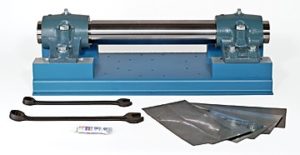Focused Training Key For Industry
Is the pandemic over? Some days it’s difficult to tell, as the ripple effects of continued cases of COVID-19 continue to pop up and create problems for both workers and manufacturers. Although the severity of pandemic-related disruptions has certainly subsided, industries around the world are still struggling with the aftershocks of a tumultuous few years.
In addition to ongoing supply chain woes, manufacturers are also contending with a labor marketplace that has changed fundamentally as a result of the pandemic. Prior to the pandemic, industry was struggling to fill open positions with qualified workers. Today, these struggles remain and in many areas have gotten even worse.
As a result, industries are placing a great emphasis on skills assessment to ensure that new hires can hit the ground running. In addition, upskilling current employees has taken on new significance, as industries seek to make the most of available human resources when it’s difficult to hire qualified new workers.
In this article, we’ll take a look at the current skills gap, the type of skills assessment and training that industry needs, and how the training tools offered by DAC Worldwide can help employers and instructors assess and train workers for the jobs of today and tomorrow.
How Wide is the Skills Gap?
Now that the worst of the pandemic appears to be behind us, things should be slowly getting better, right? Why then do manufacturers seem to be falling farther behind? According to an article by Alexandra Johnson:
“Before COVID, the situation was bad, but post-pandemic it has become even worse. Despite lockdown lifting, the industry is reporting over 515,000 jobs need filling, just to meet demand.”
Commonly known as the “skills gap,” there remains a sizeable disparity between the supply of highly-skilled workers and the demand for these workers in today’s industrial labor market. In fact, experts predict the skills gap is going to get even worse in the foreseeable future.
A study conducted by Deloitte for the Manufacturing Institute estimates that, over the next decade, almost 4.6 million manufacturing jobs will need to be filled. However, because of the skills gap, as many as 2.4 million — more than half! — of those jobs could go unfilled.
In a recent Forbes article, author Graham Glass notes that “[n]early half (46%) of learning and development (L&D) leaders say the skills gap is widening in their organization, and 49% say executives are concerned employees don’t have the right skills to execute business strategy, per findings from LinkedIn Learning’s ‘2022 Workplace Learning Report.’”
What is industry to do? Glass advises that “organizations need to emphasize employee upskilling, reskilling and right-skilling — and anticipate the skills employees need to succeed in their positions…By assessing the business’s needs pre-training (to develop training content) and post-training, companies can work to bridge skills gaps and create training programs that are impactful and useful to employees and the organization alike.”
Skills-Based Hiring
What’s the best approach for industry to take to bridge the skills gap? Should industry simply hire anyone they can get their hands on and then train them to do the jobs they need done? For many reasons, that strategy is probably not the best solution.
Industry is already struggling with a host of issues left over from the pandemic. Most companies don’t have the bandwidth to babysit new workers while they acquire the training they need. Many also don’t have either the personnel or the tools to effectively train new workers.
That’s why, in an article in the Harvard Business Review, LinkedIn CEO Ryan Roslansky advocates for a new skills-based approach to hiring. Roslansky urges employers to “[f]ocus on the results you’d like to see, rather than the type of qualifications that you think could deliver them. Highlighting the desired skills — the candidate’s ability to perform certain tasks — gets to the same results without creating an unnecessary barrier to entry, like a requirement for a four-year degree.”
In an article by Adina Miron, the author agrees:
“Skills-based hiring enables employers to hire for the skills gaps that exist within their organization. Rather than focusing on experience, education, or certifications, companies should focus on identifying candidates with the needed skills to fill open positions.”
Roslansky echoes these thoughts:
“Shifting to a skills-focused approach is a viable solution to an evolving workforce dilemma…Stay focused on skills — and the assessments that can measure them…there are plenty of ways to gauge a candidate’s ability to perform without relying on their education or experience as proxies.”
How do employers shift to a skills-based hiring approach? Unfortunately, generalized assessments and comprehensive training systems can be difficult to use in the context of hiring new workers in industry. Why? The answer can be found in the concept of specialization of labor.
According to an article by Sampson Quain:
“Specialization of labor…refers to a process in business in which large tasks are divided into smaller tasks, and different employees or different groups of employees complete those tasks. Specialization is highly desirable in large-scale operations such as…manufacturing because it allows workers with specific skill sets to efficiently perform a specific task.”
For example, a manufacturer may need to hire someone with a specific skillset related to the operation, maintenance, troubleshooting, and repair of mechanical belt drives. A prospective candidate might claim to have general mechanical knowledge and skills, but how can the employer know whether the worker has the specific belt drive skills it needs?
To effectively use a skills-based hiring approach in manufacturing, employers need focused assessment and training tools that can be used to adequately determine a potential worker’s skills in a very specific area.

Training at the Speed of Industry
Industry must also dedicate resources to ongoing training for current workers. The need for ongoing training is real and cannot be ignored. Industries today need to attack the skills gap with a combination of skills-based hiring and instituting training of current workers that is practical and effective.
In his Forbes article, Glass argues that “a personalized approach to training can also be useful to employees and companies.” However, he acknowledges that, “[i]n large companies, especially, creating individualized learning paths manually can be time- and resource-intensive.” He also points out that “employees need training that fits into their workflows.”
Most companies cannot afford the luxury of sending workers off-site for a week or more at a time for in-depth training. Instead, they need focused, skills-based training that allows workers to obtain the hands-on skills they need while minimizing the effect on production of time away from the workplace.
Fortunately, a variety of training tools exist that can offer industries time-saving, cost-effective solutions for focused skills assessment and hands-on training. In the next section, we’ll take a closer look at DAC Worldwide’s range of single-topic trainers that can help industry move to a skills-based hiring model and also upskill current employees.
DAC Worldwide Offers Focused Assessment & Training Tools
DAC Worldwide offers training systems for a variety of industry sectors, including advanced manufacturing, process/chemical manufacturing, marine, military, oil and gas, and power generation. These training systems also cover many different technical topics, such as electrical and electronics; heat transfer and steam; mechanical drives; oil production; process control and instrumentation; and pumps, compressors, and valves.
Rather than broad-based training in multiple areas, DAC Worldwide’s training systems provide hands-on training focused on specific tasks. This makes them particularly helpful to employers for skill assessment (either pre-employment or for upskilling purposes). For example, DAC Worldwide offers training systems targeted specifically at key mechanical maintenance skills:
Belt Drive Training System
The Belt Drive Training System (201-000) allows for convenient assessment and training in the identification, installation, tensioning, and alignment of common belt drives types found in industry. Featuring hardware for applications related to multiple matched belts, fractional horsepower belts, positive drive belts, and variable pitch sheaves, the system provides a variety of training and assessment applications in one benchtop piece of equipment.
Coupling/Shaft Alignment Trainer
The Coupling/Shaft Alignment Trainer (208-000) allows for realistic training and assessment in shaft alignment. Designed based on the dimensions of a common ANSI centrifugal pump, this trainer can assess and train workers on all common alignment techniques and tools. Training and assessment topics include using a dial indicator in coupling/shaft alignment, the reverse dial indicator method, fabrication of shaft keys, and installing a flexible disc coupling.
Chain Drive Training System
The Chain Drive Training System (223-000) allows for in-depth assessment and training in industrial chain drives, heavy/silent chains, and sprocket set usage. Using industry-standard components workers will encounter on the job, this training system provides a complete training and assessment experience covering topics such as taper lock bushings, chain drive maintenance, installation/alignment of chains, and tensioning of chains.

Let DAC Worldwide Help You Fill Your Skills Gaps
The mechanical assessment and training tools highlighted above are just a few examples of the variety of technical training tools DAC Worldwide manufactures. In addition to training systems, DAC Worldwide also offers a wide range of industrial cutaways, detailed scale models, and sample boards featuring industrial components.
Contact a consultant with DAC Worldwide today to learn more about how their technical training tools can help you build the assessment and training program your company needs. Using DAC Worldwide training and assessment tools, you can transition to a skills-based hiring approach and fill the skills gaps in your organization!
About Duane Bolin
Duane Bolin is a former curriculum developer and education specialist. He is currently a Marketing Content Developer in the technical training solutions market.
- Published in News
Building a Mechanical Drives Training Program | Amatrol & DAC Worldwide Offer Complementary Training Solutions
To read ‘Building a Mechanical Drives Training Program’ as a Multimedia presentation, please click here.
Essential workers come in all shapes and sizes.
Without properly functioning mechanical drives, robots wouldn’t be able to perform automated commands, conveyor belts would lay still, and machining centers would grind to a screeching halt. Machine breakdowns couldn’t be fixed without them.
Local industry needs more technicians with specific skillsets, including proficiency in working with mechanical drives. What’s needed are more in-depth programs that not only provide hands-on skills, but take learning beyond the classroom with full, interactive eLearning.
With traditional education facing unprecedented uncertainty, building a sought-after Mechanical Drives Training Program is becoming a high priority for high schools and colleges around the nation. And thanks to Amatrol and its new sister company, DAC Worldwide, constructing a dream Mechanical Drives Training Program is now easier than ever.
What Good Comes With Mechanical Training?
Frankly, mechanical drives are found in almost every aspect of life and countless industrial sectors, such as agriculture, pharmaceuticals, automotive, construction, power & energy, industrial maintenance, mining, and more.
Thanks to its worldwide use, mechanical maintenance technicians are highly sought after. Positions are available, with more on the way thanks to a large chunk of Baby Boomers approaching retirement age.
However the importance behind mechanical training can eventually be attributed to the impending Skills Gap, which has the potential of leaving millions of jobs unfilled due to a lack of qualified workers. Thanks to equipment that is becoming more technologically advanced by the day, few can perform routine maintenance that must be learned and practiced to gain proficiency.
Today, mechanical maintenance technicians are expected to possess a very specific, highly technical skillset. So in order to meet those expectations, current mechanical training should cover everything from bedrock fundamentals, all the way through advanced manufacturing applications.
In addition, the training should not be one-dimensional. While hands-on training allows students to take a more tangible approach to training, theoretical understanding of the topic brings the knowledge full circle. One without the other would be doing a disservice to not only the students, but any customers they may encounter on their professional journey.
How DAC Worldwide & Amatrol Can Legitimize Your Mechanical Drives Training
No matter how advanced your mechanical drives training may (or may not) be, Amatrol and DAC Worldwide can add the substance to take your program to the next level.
DAC Worldwide and Amatrol joined forces in 2019 after discovering that their training systems complemented each other to create an ever more robust training. As worldwide leaders in technical training, the goal of the “sister companies” was to provide even more technical training opportunities for schools and companies in need, especially in the field of mechanical drives.
However the real winners in the combining of these two technical training companies? The learners. While Amatrol and DAC Worldwide may be in the forefront of technical training, the approach taken by the two companies varies slightly.
What this means is even more opportunities for learners to strengthen their skills before entering the workforce. It also gives schools and training facilities more options when building their program, as Amatrol’s and DAC Worldwide’s products complement each other for a well-rounded classroom.
For example, Amatrol has unmatched eLearning curriculum, as well as unparalleled depth and breadth of coverage. The learning systems, which are available in both portable and full-size models, offer thorough, in-depth training that can be added on as training needs grow or change. A typical lesson will see students start with the basics, like identification and definition, before moving on to more challenging topics, like troubleshooting and implementation.
DAC Worldwide, on the other hand, creates training systems, models, cutaways, and sample boards of various mechanical drives. Each product is intended to train students on a specific set of technical topics. So if instructors have a particular skill they have identified as the most appropriate – like belt drive training (201-000) – a DACW training system will focus solely on that particular skill. Or for those that need a perfect tool for skill evaluation for pre-hire or annual skill testing, DAC Worldwide’s products would be the ideal solution. In turn, with its focused scope, these trainers could be a less expensive alternative to large-scale systems.
Amatrol and DAC Worldwide Mechanical Training Solutions
As mentioned, both Amatrol and DAC Worldwide provide mechanical training, but do so in slightly different, yet complementary, closely-aligned ways that further enhance training.
Amatrol built a platform that has a broad range of skills on its base levels, with the opportunity for expansion. By adding an optional system, users can create a system that is unmatched in its depth and breadth of training. Amatrol’s Mechanical Drives 1 Learning System (970-ME1) does it all in a compact system and also includes interactive eLearning.
DAC Worldwide, on the other hand, built individual systems that focus on more specific skill training. Users can easily expand the number of trainers used for more in-depth skill-building, or use the trainers as a tool for learners’ final assessment. It’s also ideal for adult training, if local industry wants their employees to have specific training, such as coupling alignment (206-000), without the need for belts, chains, and other components.
While both approaches lead to successful technical training, many of DAC Worldwide and Amatrol’s products work hand-in-hand for seamless integration into any Mechanical Drives program.
So if you’re looking for a way to expand (or begin) a Mechanical Drives Program, here are a few solutions on how to implement trainers from both DAC Worldwide and Amatrol:
Solution #1: Mechanical Drives Learning System | 970-ME1 (Amatrol)
The “crown jewel” of mechanical training products, Amatrol’s 970-ME1 covers countless industry-needed skills in one convenient system. The Mechanical Drives 1 Learning System covers alignment and operation of mechanical drives, and alignment and applications of various motor drive systems.
Accompanied with online mechanical drives curriculum to gain theoretical knowledge, this system also provides hands-on skill training for shaft, belt, gear, and chain drives using real-world motor drive components. Students will cover topics like mechanical drive systems, key fasteners, power transmission system, v-belt drives, and much more.
With the 970-ME1, Amatrol expertly mixes theoretical concepts immediately followed by hands-on practice to build the strongest possible retention and competency for learners. It includes Amatrol’s world-class eLearning curriculum, as well as expansion units to further training, such as:
- Mechanical Drives 2
- Mechanical Drives 3
- Mechanical Drives 4
- Laser Shaft Alignment*
- Vibration Analysis*
- Roller-Pack Machine Tool Axis
- Plain Bearing Machine Tool Axis
- Floor-Standing Belt Conveyor
- Machine Tool Chip Conveyor
- Predictive Maintenance Vibrations Analysis
* Also Available as Stand-Alone Training System
Solution #2: Single-Topic Trainers (DAC Worldwide)
Single-topic trainers focus on one core subject matter, making it useful for applications where there is a greater need for training on a specific topic. Not only can these DACW trainers extend your training lab to accommodate more students at a very low cost, but they can add to Amatrol’s 970-ME1 system.
Belt & Chain Drives
DACW’s Belt Drive Training System Plus (201-PAC) focuses on the identification, installation, tensioning, and alignment of common belt drives types found throughout industry. It includes flanged bearings, fractional horsepower belts and sheaves, multiple Type-A belt sets, sheave bushings, and more.
Available in: 201-000, 201-PAC
The Chain Drive Training System Plus (223-PAC) presents learners with industrial chain drives, heavy/silent chains, and sprocket set usage, providing a complete introduction to chain nomenclature, assembly, disassembly alignment, and maintenance.
Available in: 223-000, 223-PAC
Gear & Bearing Maintenance
DAC Worldwide’s Gear Maintenance Training System Plus (205-PAC) is the ideal training tool to learn how to install, align, troubleshoot, and repair a wide variety of gears, shafts, and bearings. Learners will be introduced to gear identification, installation, alignment, and troubleshooting.
Available in: 205-000, 205-PAC
The Advanced Bearing Maintenance Training System Plus (204E-PAC) allows for in-depth training in the identification, installation, and removal of various industrial-quality rolling element bearings. Using two workstations, students will study topics such as bearing identification systems, rolling element bearing construction, bearing maintenance pre-check, and more.
Available in: 204E-000, 204E-PAC
Coupling / Shaft Alignment
For convenient, realistic training in shaft alignment, look no further than DAC Worldwide’s Basic Coupling / Shaft Alignment Training System Plus (208D-PAC). The design is based on the configuration found in many vertical centrifugal pumps, and accommodates all types of alignment apparatus, including laser systems. Learners will perform four-point motor element jacking, master a dial indicator in coupling/shaft alignment, troubleshoot angular and parallel misalignments, and install a flexible disc coupling.
Available in: 208D-000, 208D-PAC
Brake Clutch
 Using a completely motorized training package of brake and clutch-related hardware and control components, DACW’s Brake Clutch Training System (220-PACP) explores how brakes and clutches are used for training throughout various sectors. The trainers covers the installation, operation, and troubleshooting of brakes and clutches in a variety of applications.
Using a completely motorized training package of brake and clutch-related hardware and control components, DACW’s Brake Clutch Training System (220-PACP) explores how brakes and clutches are used for training throughout various sectors. The trainers covers the installation, operation, and troubleshooting of brakes and clutches in a variety of applications.
Available in: 220-000, 220-PACP
Solution #3: Enhancement Trainers (DAC Worldwide)
In addition to single-topic trainers, DACW also offers Enhancement Trainers.
Basically, Enhancement training systems cover skills that are not currently included in Amatrol training systems, specifically the 970-ME1. These units have the same look and feel as single-topic trainers, but can extend the training capabilities of Amatrol mechanical learning systems.
Advanced Coupling / Shaft Alignment
DAC Worldwide’s 3-Component Coupling Shaft Alignment Training System Plus (206-PAC) is patterned after a typical turbine-driven pump or turbo-compressor. The system includes flanged bearings that allow changes in angular and parallel misalignment, motor attachment points with steel-threaded inserts, and replaceable shaft for easy installation of bent shafts.
Available in: 206-000, 206-PAC
With a design based on the configuration found in many vertical centrifugal pumps, DACW’s Vertical Coupling / Shaft Alignment Training System Plus (207-PAC) features industrial-grade components to perform a four-point motor element jacking, install a flexible disc coupling, and troubleshoot angular and parallel misalignments.
Available in: 207-000, 207-PAC
Fan Balancing
DAC Worldwide’s Fan Balancing Training System Plus (202-PAC) encourages learners to gain experience with fan balancing in an effort to achieve maximum fan efficiency and stability. Designed to look and perform like a typical squirrel cage fan, it comes with movable pillow block assemblies and can feature even or odd number blade configurations.
Available in: 202-000, 202-PAC
Vibration Analysis
Using DACW’s Vibration Analysis Training System Plus (203-PAC), students will be introduced to a versatile, precision-machined device that isolates individual, vibration-causing variables in order to demonstrate their individual signatures. Topics include effects of frequency/displacement, proper pick-up mounting, correcting vibrations caused by imbalance and misalignment, and more.
Available in: 203-000, 203-PAC
Advanced Bearing Maintenance
The Journal and Fluid-Film Bearing Training System Plus (204J-PAC) trains learners in the identification, installation, removal, and maintenance of a variety of Babbitt-type journal bearings found on high horsepower, high-speed rotating machines. Using two workstations, students practice common maintenance tasks, such a bluing check, dent repairs, and hand scraping.
Available in: 204J-000, 204J-PAC
Let Amatrol and DAC Worldwide Help You Build Your Ideal Mechanical Training Program
No matter what kind mechanical training you’re looking for, or what skills you’d like to focus on, the world-class training tools of Amatrol and DAC Worldwide should have you covered. With almost 80 combined years of technical training experience, no other company on the market can match us!
For more information on how to build your ideal mechanical training program, please click here.
- Published in News



















